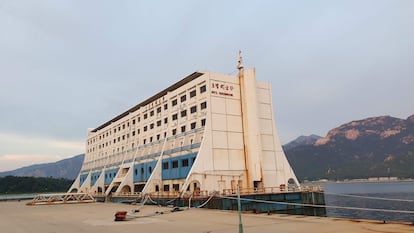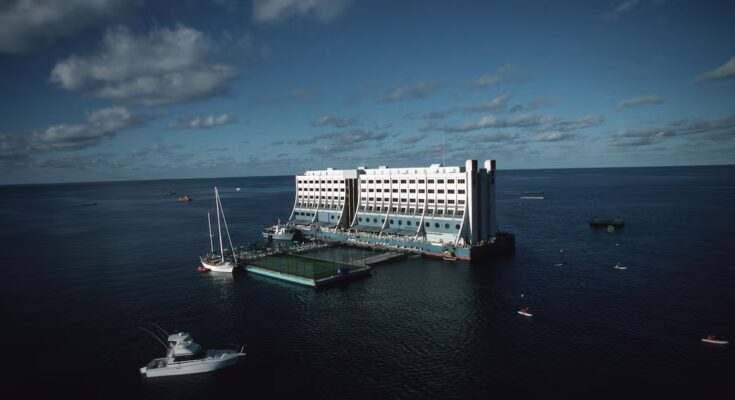In 1959 a group of Japanese architects signed a document entitled Metabolic Manifestowhich was, excuse me, a journey in a vessel of planetary proportions: flying cities, megastructures growing like living organisms, capsules enclosed in enormous towers. Architecture like science fiction but serious, and formidable even from an exclusively aesthetic point of view. Big names have passed through there: Arata Isozaki, Kisho Kurokawa and, above all, the absolute boss of the exhibition, the modern patriarch of Japanese architecture: Kenzo Tange. The same one who, in 1960, signed one of the most ambitious (and crazy) urban plans of all time: the plan for Tokyo Bay.
We see. Tange’s plan was another of those colossal fantasies with gigantic concrete structures floating on the Sea of Japan as if they were technological mantas, or naval cities designed for a civilization more determined than ours. Because of course yes, Kenzo, you have to be in the right position to propose something like this and defend it with a serious face. However, the plan was not realized for two quite reasonable reasons:
- It was a manifesto in the form of a project: a spectacular way to say “hey, metabolism is serious”.
- And, well… why How the hell are we going to build this, Kenzo? It’s very nice to dream, but there are limits, man.
But here we make the leap: Australia, 1980s. Meet Doug Tarca, an Italian immigrant living in Townsville, a northeastern coastal city known more for dock work and cold beer than fine tourism. Doug was a professional diver, scuba diving entrepreneur and apparently a “more is more” enthusiast. Because one day, perhaps seeing Tange’s plans or simply remembering how well things float if you put air underneath them, he said: “We’ll build a hotel in the middle of the sea. Just because.”
And he did it. Well, he tried. With the help of a Swedish oil rig company, he built what he called the Four Seasons Barrier Reef Floating Resort. name). It was not a ship or a cruise ship. It was a building. A mass of seven floors, 200 rooms, a heliport, a tennis court and twenty panoramic rooms below sea level to see the Great Barrier Reef up close. Anchored miles from shore thanks to the action of six giant anchors. They called him flotel. And yes, it was as wacky as it sounds.

It opened in 1988. It was on magazine covers, it was on television, the whole country was talking about it. flotel from Townsville. Tourists came from every corner. Yet, the following year, it closed.
What happened? Well, several things. To begin with, by anchoring the structure, they destroyed a considerable portion of the coral that tourists would come to admire. Bad idea. And then, the building was rocked by a cyclone that swept away the helipad and left the underwater rooms chrome-plated. Result: economic losses. Doug, with more enthusiasm than cash, sold the hotel to a Japanese company.
The new owners thought about keeping it there, in Australia, until a small detail appeared. Under the building, next to the anchors, there were more than one hundred thousand artillery pieces and anti-tank mines from the Second World War. YES. Right below. Marvelous.
So the Japanese chose to move the flotel. Literally. They loaded it onto a superfreighter and took it around the Pacific: 12,000 tons of concrete sailing like the sailing brig Espronceda. In 1990, the hotel docked in Ho Chi Minh Port was renamed the Saigon Floating Hotel and reopened. They removed the tennis court, added a pool and an artificial beach, and for a decade it was a total success.

But at the end of the nineties, new crisis, new sale. This time the only interested party was Hyundai (yes, the car company), but to place the matter in none other than North Korea. Apparently, one of the branches of the South Korean megacorporation has important interests in several areas bordering North Korea, so in 1999, the flotel He landed on the semi-touristy shores of Mount Kumgang, near the Demilitarized Zone, they renamed it again (this time Hotel Haegumgang) and, strange as it may seem, it was there that he experienced his most emotional moment.
During a brief period of détente between the two Koreas, the flotel It was a meeting point between families separated for half a century. The hotel only accepted American dollars and South Korean won, which created some financial intrigue, but no one was asking for too much: the rooms were luxurious, the sea was close, and the family reunions were genuinely heartwarming.
But, like in any good story, things went wrong. In 2008, a North Korean soldier accidentally killed a South Korean tourist. Tensions skyrocketed again, visits were suspended and the flotel He was trapped in a diplomatic limbo from which, as far as we know, he has not fully emerged.
Until, in 2023, North Korean authorities decided it was good enough and scrapped it. End of the journey. The end of a structure that in twenty years had fluctuated for more than 14,000 kilometers, crossed three countries, two seas, a recycled cold war and a couple of dreams that were too big. Doug Tarca’s, for example. It didn’t go well at all. But at least it worked for a while, which is more than many dreams can say.


